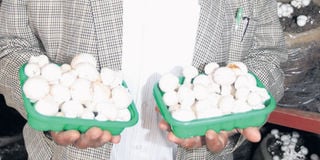To reap more, grow button mushrooms

The four popular exotic mushroom species currently grown and consumed in Kenya are Button Agaricus bisporus, the Oyster Pleurotus spp, Shiitake Lentinula edodes and Reishi Ganoderma lucidun. FILE PHOTO | NATION MEDIA GROUP
What you need to know:
- The bulk substrate materials used are wheat straw, chicken and horse manure (some use urea if horse manure is not available) supplemented with cotton seed cake and molasses. Thorough mixing of these components is done manually.
- Watering directly on the compost would cause rot and consequently no mushroom would develop. The casing material also acts as a buffer. Pasteurised virgin forest soil can be used as casing material.
- Some farmers recase the bags to prolong this period. The most economical harvesting period takes six weeks. Picking mushrooms is done with clean hands, with a light rotating movement, taking care not to bruise the caps.
The four popular exotic mushroom species currently grown and consumed in Kenya are Button Agaricus bisporus, the Oyster Pleurotus spp, Shiitake Lentinula edodes and Reishi Ganoderma lucidun.
Out of the four, Oyster mushrooms are the easiest to cultivate, growing in a wide range of substrates and temperatures, and thus referred to as “mushrooms for all seasons”. They are also the most common in Kenya.
However, Button mushroom has the highest demand, with Kenya importing up to 80,000 tonnes to satisfy its tourist industry. Due to its complicated growing process, many farmers shun it. But with the know-how, this variety pays handsome dividends.
Preparation of substrate for Button mushroom follows a complex two-stage process involving composting followed by pasteurisation. The bulk substrate materials used are wheat straw, chicken and horse manure (some use urea if horse manure is not available) supplemented with cotton seed cake and molasses. Thorough mixing of these components is done manually.
The straw is used whole and put in a pile for mixing purposes and aeration. The process starts with pre-wetting the straw for five to six days. If urea is used, it is added on the third day of turning. Chicken manure is added on the fourth day of turning and horse manure on the sixth. Cotton seed cake and molasses are added on the seventh day of turning. On the ninth day, the straw is piled in a block of 1.5m wide and 1.5m high. In this state, the temperatures are allowed to rise, which encourages high temperature microorganisms that break the straw to flourish. The process of composting (first phase) takes 15 to 21 days.
ALLOWED TO SETTLE
The compost is allowed to settle so that it is more or less uniform throughout. This may take up to 10 hours and is called equalising or levelling. Thereafter, pasteurisation (also called the kill) phase occurs where the temperature is allowed to rise to 60 degree Celsius (either by itself or by the introduction of steam from water boiling in oil drums).
The temperature is held at this level for eight to 10 hours. After pasteurisation, the temperature of the compost is reduced to 48 degree Celsius for conditioning— a process that usually takes four days. In total, Phase II usually takes six days. At the end of conditioning, the compost must be stable and free from ammonia. It is then cooled to around 25 degree Celsius by circulating filtered air through the material.
After spawning, the bags should be incubated at 25 degree Celsius to 27 degree Celsius, which is the optimal temperature for mycelial growth. Fully grown compost is colonised by mycelium, giving it a white or grey colour.
It is, however, not yet ready to produce a good crop of mushroom. It requires a casing layer that provides the right bacteria and the right amount of water to stimulate the mycelium to form a good crop.
Watering directly on the compost would cause rot and consequently no mushroom would develop. The casing material also acts as a buffer. Pasteurised virgin forest soil can be used as casing material.
Ruffling is the procedure of lightly raking the casing soil to get a more uniform mycelial growth. Ruffling breaks the mycelium in the casing soil layer, stimulating regrowth and soon a fluffy white appearance is observed on the layer. When pin heads are observed, conditions are changed in the room to initiate fruiting.
IRRIGATION IS IMPORTANT
Using air ventilation, compost temperature is reduced to approximately 20 degrees Celsius within a few days. Irrigation is important— spraying water using an atomiser maintains the humidity at 95 percent and also helps to lower the temperatures of the compost to the desired range.
Alternatively, one can hang wet sterile sacks in the mushroom growing rooms. The sacks can be sterilised by boiling them using an oil drum. Opening windows and doors ventilates the room and soon pinheads develop into buttons.
Increased ventilation drops the temperature, introduces oxygen and reduces carbon dioxide, and consequently changes the mycelium from vegetative to reproductive stage and fruiting is initiated.
Harvesting is expected three weeks after casing. It is achieved by hand picking and takes weeks depending on the growers schedule and quality of the compost.
Some farmers recase the bags to prolong this period. The most economical harvesting period takes six weeks. Picking mushrooms is done with clean hands, with a light rotating movement, taking care not to bruise the caps. Mushrooms must not be watered before picking as water reduces their shelf life. Watering is done immediately after harvesting. Farmers are cautioned to use clean water for watering to avoid contaminating the mushrooms.
The author teaches at Egerton University’s Department of Biological Sciences.




